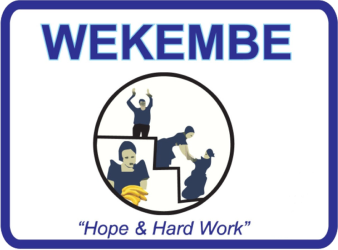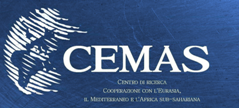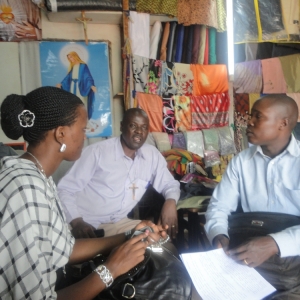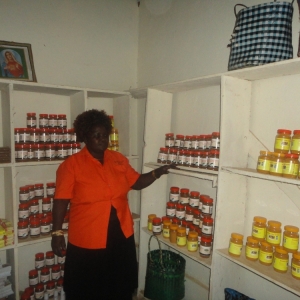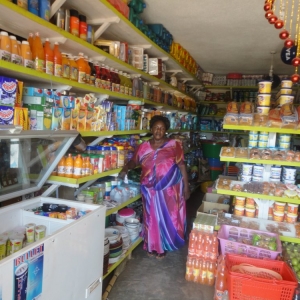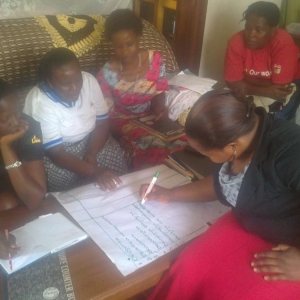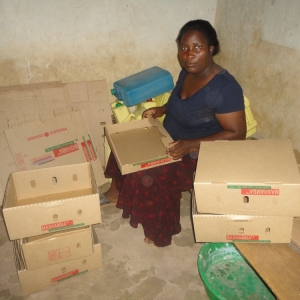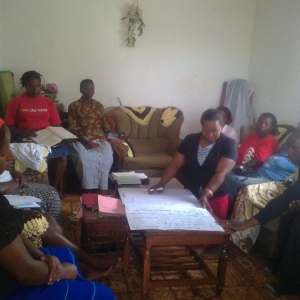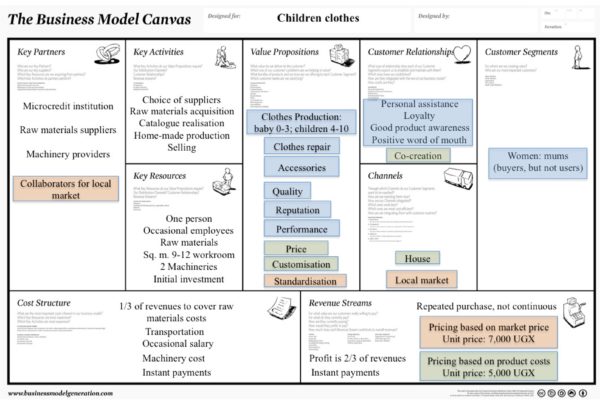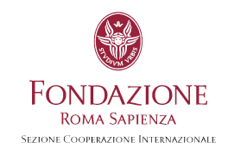The implementation of the model for a children clothes business
The Business Model Canvas has been adopted to analyse and reproduce several business models operating in Uganda.
1. Description of the business
More precisely, the first case study considered in this report concerns the investigation of a children clothes business. The business model canvas reported in Fig. 1 represents the definition of a business, which has been realised from the analysis of a successful business, managed by Cissy Nadamba.
The aim of this business model canvas consists in defining and describing the successful factors characterising a children clothes business, undertaken by a person working 10 hours per day to fully satisfy the customer demand and reaching at least revenues for 400,000 Ugandan schillings and approximately profit for 250,000 Ugandan schillings in a profitable month.
2. Building blocks description
Customer segment
The main customer segment, which is possible to identify is constituted by women of different ages, the majority of them are mums, who buy products for their children. For this reason, it is conceivable to set that they are the buyers of these goods, but not the users, due to the typology of needs satisfied by products.
Value propositions
The typology of products and services offered to customers consists in two main categories. The former, which is the most relevant and profitable business concerns the handmade production of clothes for babies aged between 0 and 3 and for children aged between 4 and 10. The production of clothes comprises basic clothes for children and school uniforms. The latter consists in realising specific sweaters with the emblem of the membership school or in just embroidering that symbol on previous owned sweaters. The entrepreneur also offers hand-made accessories, such as special decorations for cribs. Since they need elevated investments in time and labour to be prepared, the market price of these products is high and few people have economic possibilities to buy them.
The second service offered for this business is the mending of all kinds of clothes, not only for the ones for children. Even if the clothes production allows higher profit margins, this additional service could be offered by the entrepreneur to overcome a difficult period in term of clients demand and gains. Instead of not producing, she might take advantage of her ability in sewing by offering the mending of garments. The principal values indistinctly offered to clients through products are high quality, performance and reputation, due to the hand-made production process and the increased experience.
On the basis of the different channels adopted for the distribution of products, the offered value changes. Low price and product customisation are accessible to local people, who have not high income to spend and that choose personally the characteristics of products by reaching personally the house of the entrepreneur. On the other side, selling products on local markets insures incremental margins of profit. In that marketplace, offered products are standard, due to the immediately availability of goods to be sold and clients are willing to pay higher prices.
By considering the typologies of offered values, this business runs in the opposite side as it usually does. In this specific case, the lower price is paid for customised products, that clients can demand for, by consulting a catalogue at the entrepreneur’s workroom. Differently, higher prices are demanded for the same products, but not customised on the basis of clients’ requirements. Customisation has usually considered as an adding value, for which companies want to be paid more by petitioners.
Summarising, the value propositions identified for this business are two, due to the adoption of two different kinds of channels, which substantially reach the same customer segment, but composed by people who have different levels of income to spend for those products.
Channels
The entrepreneur sells the products to clients mainly at her house, where she has the workroom to produce clothes. Due to the good reputation and the positive word of mouth of clients concerning this handmade business, the entrepreneur may benefit form several clients, who reach her at home to buy the products. This channel lacks of accessibility and visibility that she could compensate with a copious clients demand from local people. As mentioned above, the price paid by these customers is not elevated due to the poor conditions in which they live. The adoption of this channel is considered as a sub-optimal strategy because of the greater margins of profit she could collect by selling at the local market.
The local market is considered a potential channel to be exploited as through it the entrepreneur might reach a large number of clients, set higher prices and increase the product awareness. In fact, by experimenting the adoption of this channel thanks to the support of a collaborator, it is possible to figure out that clients are willing to pay at least 7,000 Ugandan schillings for the same product at the local market, instead of 5,000 Ugandan schillings at home. The most relevant weakness of this channel lies in the high cost that the entrepreneur has to support for transportation to reach the market and family problems.
The suggestion consists in verifying whether the higher margins, which are possible to collect at the local market, cover the great costs incurred by adopting this channel.
Some potential solutions to solve this weakness are the alternative implementation of a direct or indirect method. The former consists in searching for a partner to start collaboration with in order to incur in lower prices of transportation due to the possibility to share them. The latter always concerns an alliance through which the entrepreneur might sell her products, by entrusting the children clothes to a seller, who visits local markets frequently.
Customer relationships
The customer relationship consists of an entrepreneur’s personal assistance towards her clients, due to their consuetude to buy products personally at her house. This kind of relationship enforces the personal interaction and gives the possibility to customers to co-create their products on the basis of their requirements and specific preferences.
The high quality of handmade children clothes has promoted the diffusion of a positive word of mouth and the products awareness among clients. Therefore, this represents a solid basis to make and keep loyal consumers.
In order to increase the awareness of her business and products, the entrepreneur might make business cards to distribute among clients and potential clients to increase the consciousness on her handmade activities.
Revenue streams
The typology of offered products influences the frequency of clients’ purchases. They occur in a repeated way, but not continuously. Mums buy clothes on the basis of children’s necessities, due to the scares economic resources they have. Considering the biological cycle, an incremental growth from 0 year old babies to 10 year old children forces mums to buy new garments until kids become teenagers. For this reason, it is reasonable to consider these clients not permanent.
The flow of revenues is well balanced with the one of costs because of the instant payments characterising both statements. In fact, clients who buy children clothes instantly pay the entrepreneur for their purchase.
As mentioned in the description of the business, in a profitable month the entrepreneur might collect revenues for 400,000 Ugandan schillings. As profit is considered to be about the 2/3 of revenues, it is possible to set that in that favourable condition, the rough income for the producer is about 250,000 Ugandan schillings.
For what concerns the pricing of products, the entrepreneur implements a different method on the basis of the adopted channel. Considering sales in the local market, situated in urbanised areas, it is possible to identify a product unit price established on the basis of the market price. As reported above, in these zones, clients are willing to spend more even if the children clothes are standardised. On the contrary, considering the local area where the entrepreneur lives and works, the product unit price has been established starting from the amount of the product cost plus a mark-up.
Key resources
There are some relevant resources which let the business start and work continuously. This children clothes business requires the full-time presence of the producer that works for about 10 hours per day in order to face greatest orders. In this situation, the entrepreneur might employ other 2 collaborators, more precisely one for production and one for sale, to satisfy the clients’ demand. Most of the times, these partners are entrepreneur’s relatives and this lets her pay them a low salary or nothing.
Raw materials are required to start the production and in this specific business the acquisition of fabrics, laces and sewing threads is fundamental. The entrepreneur personally buys these resources at the local market, by choosing them on the basis of client’s requirements and supplier’s availability.
Another key resource is the disposal of a workroom, at least between 9 to 12 square metres, in order to use it as a laboratory and allows the containment of the stock. The entrepreneur gets it inside her house, by allocating a room to produce her clothes, as shown in Fig. 2.
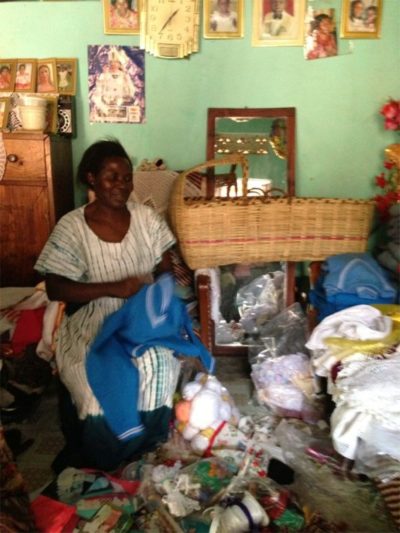
Fig. 2: An entrepreneur working in the laboratory.
Due to the typology of the activity, the producer needs also at least 2 kinds of different machineries. One of these is a common sewing machine and the other one has to be more professional to allow the application of decorations. The entrepreneur might buy one of these machines and pay an affordable monthly rent for the other one – for example – thanks to a granted loan.
All the key resources mentioned above constitute the initial investment, necessary to develop a new business. In this specific case, the amount of this first investment is approximately 1 million Ugandan schillings; it considers the workroom, 1 or 2 machineries, the first stock of fabrics, evaluated about 150,000 Uganda schillings, and market costs.
Key partners
The network of actors that make the business model working is mainly constituted by raw materials and machinery suppliers, microcredit institutions and potential collaborators, in order to have a cheaper access to the local market.
The entrepreneur might receive loans from Wekembe after having followed training courses and defined a savings program. These loans are valuable resources, especially for entrepreneurs who want to start a business in developing countries where financial resources are hard to find and the awareness about that is weak.
The entrepreneur has to maintain the relation with her machineries suppliers and raw materials providers. The latter are selected on the basis of their different availability of goods and the entrepreneur almost once per month personally visits them.
The most critical potential partner concerns the presence of a collaborator, who lets to decrease the enormous expense to support selling at the local market. In order to share these costs, a partnership with a local seller might be the best solution to adopt. This alliance may foster the entrepreneur by dividing the price for the transportation or by leaving her products to someone who usually goes to the market.
Other suggested partners to develop collaborations for the provision of children clothes are schools. As the entrepreneur produces school uniforms, she might establish a co-operation, in order to ensure ongoing provision to schools.
Key activities
As mentioned above, the entrepreneur chooses the fabric suppliers on the basis of her requirements and their availability of goods; then she acquires all the raw materials she has to store.
The homemade production allows clients to customise their products by making orders on the basis of some offered prototypes. In fact, the entrepreneur proposes the consultation of a catalogue containing pictures of previously made products to show customers different productions and facilitate their choice. Therefore, the entrepreneur has to collect picture and make the book by updating it with the new productions.
Afterward, the homemade production occurs in order to satisfy clients’ needs. Once the realisation has been ended, the sales process follows.
Cost structure
The cost structure of the business has to be minimised. Its amount has to be less than the amount of revenues, in order to keep the business sustainable in the long term.
The cost of raw materials, more precisely fabrics, represents the highest cost item for this business. For that reason, 1/3 of revenues covers this expense. The occasional salary paid to irregular collaborators does not take part of this quantity, because it is informally deducted from the total revenues.
The transportation costs and relevant costs might be fixed as soon as the local market is adopted as an additional channel for the distribution of products. Among fixed costs, the machinery fee is paid each month thanks to the granted loan.
As mentioned for revenues streams, the payment to suppliers occurs instantly and it balances the flow of inflows and outflows by ensuring cash stability for the business.
